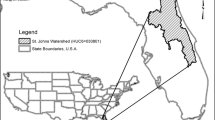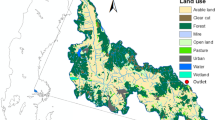Abstract
This study develops an integrated economic-hydrologic modeling to examine cost-effectiveness of wetland restoration scenarios in the 75-km2 South Tobacco Creek watershed in the Canadian prairie region. The modeling results show that spatial variations of wetland restoration costs are driven by forgone cropping returns while wetland restoration benefits in terms of total phosphorus (TP) reductions are related to wetland drainage area characteristics including slope, soil, and land use, and wetland features such as size, volume, and position relative to the stream network. For a TP reduction goal of 141.1 kg/yr or 4.3 % at the watershed outlet, the spatial targeting scenario based on economic cost to environmental benefit ratios identifies 28.8 ha of wetland restoration costing $3,058.6/yr. The cost ceiling scenario based on minimizing economic costs only would have to restore 80.1 ha of wetlands costing $8,032.6/yr. In comparison, the cost ceiling scenario requires 178.2 % more wetland restoration areas and would cost 162.6 % more than those of the spatial targeting scenario. The study contributes to develop integrated economic-hydrologic modeling to inform wetland restoration decision at farm field scale. The modeling results demonstrate the importance of spatially targeting wetland restoration based on economic cost to environmental benefit ratios in order to achieve cost-effectiveness.






Similar content being viewed by others
References
Arnold JG, Fohrer N (2005) SWAT2000: current capabilities and research opportunities in applied watershed modeling. Hydrological Processes 19:563–572
Arnold JG, Srinivasan R, Muttiah RS, Williams J (1998) Large area hydrologic modeling and assessment, Part I: model development. Journal of the American Water Resources Association 34(1):73–89
Babcock BA, Lakshminarayan PG, Wu J, Zilberman D (1997) Targeting tools for the purchase of environmental amenities. Land Economics 73(3):325–339
Bekele EG, Nicklow JW (2005) Multiobjective management of ecosystem services by integrative watershed modeling and evolutionary algorithms. Water Resources Research 41, W10406. doi:10.1029/2005WR004090
Cools J, Broekx S, Vandenberghe V, Sels H, Meynaerts E, Vercaemst P, Seuntjens P, Van Hulle S, Wustenberghs H, Bauwens W, Huygens M (2011) Coupling a hydrological water quality model and an economic optimization model to set up a cost-effective emission reduction scenario for nitrogen. Environmental Modelling and Software 26(1):44–51
Cortus BG, Jeffrey SR, Unterschultz JR, Boxall PC (2011) The economics of wetland drainage and retention in Saskatchewan. Canadian Journal of Agricultural Economics 59(1):109–126
Dahl TE (2011) Status and trends of wetlands in the conterminous United States, 2004 to 2009. U.S. Department of the Interior; Fish and Wildlife Service, Washington D.C., 108p. Available at http://www.fws.gov/wetlands/Status-And-Trends-2009/index.html. Accessed 24 Jun 2015
Dahl TE, Johnson GE (1991) Status and trends of wetlands in the conterminous United States, mid-1970s to mid–1980s. U.S. Department of the Interior; Fish and Wildlife Service, Washington D.C., 28p. Available at http://www.fws.gov/wetlands/Status-and-Trends/. Accessed 24 Jun 2015
De Laney TA (1995) Benefits to downstream flood attenuation and water quality as a result of constructed wetlands in agricultural landscapes. Journal of Soil and Water Conservation 50(6):620–626
Gleason RA, Euliss NH Jr (1998) Sedimentation of prairie wetlands. Great Plains Research 8(1):97–112
Golden HE, Lane CR, Amatya DM, Bandilla KW, Kiperwas HR, Knightes CD, Ssegane H (2014) Hydrologic connectivity between geographically isolated wetlands and surface water systems: a review of select modeling methods. Environmental Modelling and Software 53:190–206
Government of Canada (1991) The Federal Policy on Wetland Conservation. Available at http://publications.gc.ca/site/eng/100725/publication.html. Accessed 24 Jun 2015
Hart RA (1995) Mussel (bivalvia: unionidae) habitat suitability criteria for the Otter Tail River, Minnesota. MS Thesis. Fargo, ND: North Dakota State University, Department of Agriculture and Applied Science
Hayashi M, Kamp G, Rudolph DL (1998a) Water and solute transfer between wetland and adjacent uplands, 1. Water balance. Journal of Hydrology 207:42–55
Hayashi M, Kamp G, Rudolph DL (1998b) Water and solute transfer between wetland and adjacent uplands, 2. Chloride cycle. Journal of Hydrology 207:56–57
Hill MRJ, McMaster DG, Harrison T, Hershmiller A, Plews T (2011) A reverse auction for wetland restoration in the Assiniboine River Watershed, Saskatchewan. Canadian Journal of Agricultural Economics 59:245–258
Hope J, Harker DB, Townley-Smith L (2002) Long term land use trends for water quality protection: ten years of monitoring in the South Tobacco Creek Watershed, Agriculture and Agri-Food Canada, PFRA, ISBN 0662327209, 30 pages
Johnston CA (2013) Wetland losses due to row crop expansion in the Dakota prairie pothole region. Wetlands 33(1):175–182
Lawley C, Yang W (2015) Spatial interactions in habitat conservation: evidence from prairie pothole easements. Journal of Environmental Economics and Management 71:71–89
Leibowitz SG (2003) Isolated wetlands and their functions: an ecological perspective. Wetlands 23:517–531
Leibowitz SG, Nadeau TL (2003) Isolated wetlands: state-of-the-science and future directions. Wetlands 23:663–684
Leibowitz SG, Vining KC (2003) Temporal connectivity in a prairie wetlands complex. Wetlands 23:13–25
Liu YB, Yang W (2007) An interface of drainage division for modeling wetlands and riparian buffers in agricultural watersheds. Journal of Spatial Hydrology 7(1):66–80
Liu YB, Yang W, Wang X (2008) Development of a SWAT extension module to simulate riparian wetland hydrologic processes at a watershed scale. Hydrological Processes. doi:10.1002/hyp.6874
Liu YB, Yang W, Yu Z, Lung I, Yarotski J, Elliott J, Tiessen K (2014) Assessing the effects of small dams on stream flow and water quality in an agricultural watershed. Journal of Hydrologic Engineering 19(10), 05014015
Liu YB, Yang W, Yu Z, Lung I, Gharabaghi B (2015) Estimating sediment yield from upland and channel erosion at a watershed scale using SWAT. Water Resources Management 29:1399–1412. doi:10.1007/s11269-014-0729-5
Martinez-Martinez E, Nejadhashemi AP, Woznicki SA, Love BJ (2014) Modeling the hydrological significance of wetland restoration scenarios. Journal of Environmental Management 133(15):121–134
Marton JM, Creed IF, Lewis DB, Lane CR, Basu NB, Cohen MJ, Craft CB (2015) Geographically isolated wetlands are biogeochemical reactors on the landscape. Bioscience 65(4):408–418
Merino J, Aust C, Caffey R (2011) Cost-efficacy in wetland restoration projects in Coastal Louisiana. Wetlands 31(2):367–375
Mushet DM, Calhoun AJK, Alexander LC, Cohen MJ, DeKeyser ES, Fowler L, Lane CR, Lang MW, Rains MC, Walls SC (2015) Geographically isolated wetlands: rethinking a misnomer. Wetlands 35(3):423–431
National Research Council (1995) Wetlands, Characteristics, and Boundaries. Washington D.C.: National Academy Press
Pattison J, Boxall PC, Adamowicz WL (2011) The economic benefits of wetland retention and restoration in Manitoba. Canadian Journal of Agricultural Economics 59(2):223–244
U.S. Department of Agriculture (2015) Wetland Reserve Program. Available at http://www.nrcs.usda.gov/wps/portal/nrcs/detail/national/programs/easements/wetlands/?cid=nrcs143_008419. Accessed 24 Jun 2015
Veith TL, Wolfe ML, Heatwole CD (2004) Cost-effective BMP placement: optimization versus targeting. Transactions of ASAE 47(5):1585–1594
Wang X, Yang W, Melesse AM (2008) Using hydrologic equivalent wetland concept within SWAT to estimate streamflow in watersheds with numerous wetlands. Transactions of the ASABE 51(1):55–72
Yang W, Weersink A (2004) Cost-effective targeting of riparian buffers. Canadian Journal of Agricultural Economics 52:17–34
Yang W, Sheng C, Voroney P (2005) Spatial targeting of conservation tillage to improve water quality and carbon retention benefits. Canadian Journal of Agricultural Economics 53:477–500
Yang W, Wang X, Liu YB, Gabor S, Boychuk L, Badiou P (2010) Simulated environmental effects of wetland restoration scenarios in a typical Canadian prairie watershed. Wetlands Ecology and Management 18(3):269–279
Yang W, Liu W, Liu YB, Corry RC, Kreutzwiser RD (2014) Cost-effective targeting of riparian buffers to achieve water quality and wildlife habitat benefits. International Journal of River Basin Management 12(1):43–55
Acknowledgments
This research is jointly supported by the Advancing Canadian Agriculture and Agri-Food (ACAAF) Program and the Watershed Evaluation of BMPs (WEBs) program in Agriculture and Agri-Food Canada (AAFC), and Social Sciences and Humanities Research Council (SSHRC). We would like to thank Rick Andrews of Ducks Unlimited Canada (DUC), Bill Turner, Don Cruikshank, and Kelvin Hildebrandt of Deerwood Soil and Water Management Association, Dr. Mohammad Khakbazan and Cliff Hamilton of AAFC, and Katherine Packman of Alberta Innovates Technology Futures for data support, Terrie Hoppe and Brook Harker of AAFC for administrative support. We would also like to thank Marie Puddister of University of Guelph for designing figures.
Author information
Authors and Affiliations
Corresponding author
Rights and permissions
About this article
Cite this article
Yang, W., Liu, Y., Cutlac, M. et al. Integrated Economic-Hydrologic Modeling for Examining Cost-Effectiveness of Wetland Restoration Scenarios in a Canadian Prairie Watershed. Wetlands 36, 577–589 (2016). https://doi.org/10.1007/s13157-016-0768-1
Received:
Accepted:
Published:
Issue Date:
DOI: https://doi.org/10.1007/s13157-016-0768-1




